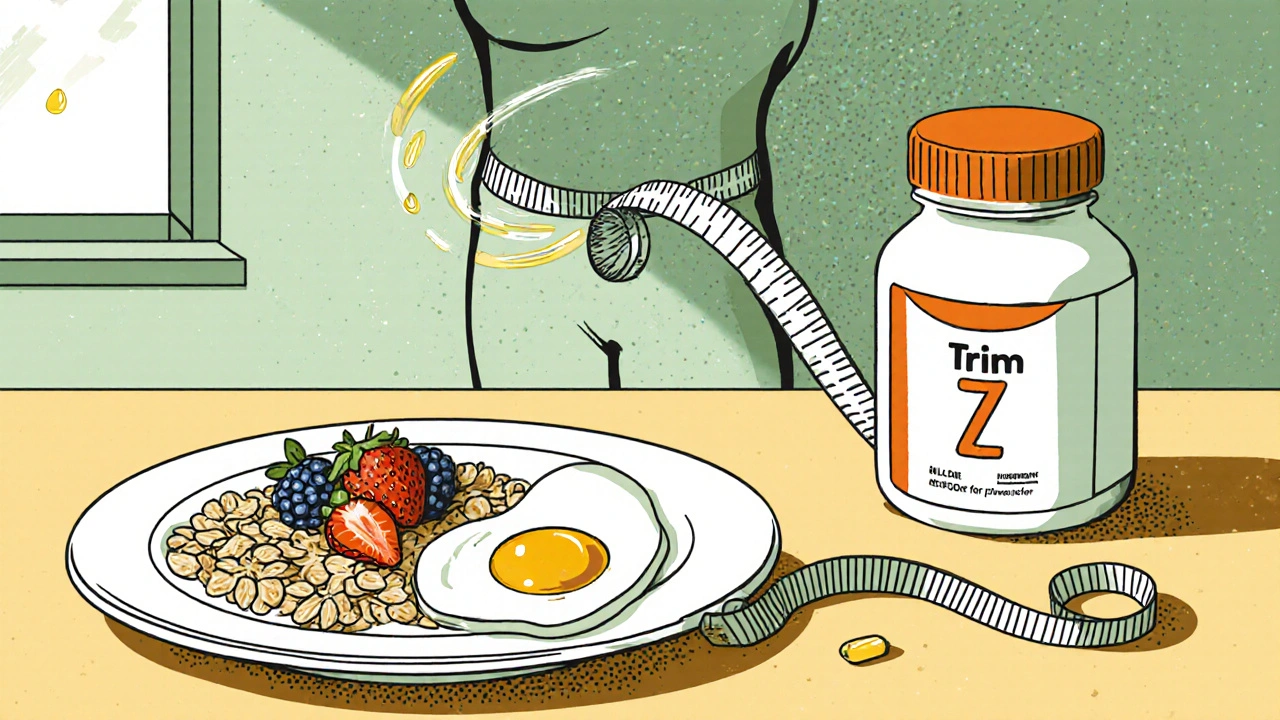Weight Loss Medication Decision Tool
Find the right weight loss medication for you
Based on your health profile, weight loss goals, budget, and lifestyle preferences, this tool will help you identify which weight loss medications might be most suitable for you.
Quick Takeaways
- Trim Z (Orlistat) blocks about 30% of dietary fat and works best with a low‑calorie, low‑fat diet.
- Prescription alternatives like Xenical provide the same active ingredient at a higher dose, while drugs such as Phentermine stimulate appetite suppression.
- Injectable GLP‑1 agonists (Liraglutide, Semaglutide) achieve the greatest average weight loss but require daily or weekly shots and have higher costs.
- Over‑the‑counter options (Alli, Garcinia Cambogia) are cheaper but deliver modest results and fewer clinical guarantees.
- Choosing the right option depends on your BMI, health conditions, budget, and willingness to follow a diet‑and‑exercise plan.
When it comes to prescription weight‑loss aids, Trim Z (Orlistat) is a lipase inhibitor that blocks the absorption of dietary fat, helping people lose weight when combined with a low‑calorie diet. But is it the best fit for you? This guide breaks down Trim Z, stacks it against the most common alternatives, and gives you a decision framework you can use today.
What Is Trim Z (Orlistat) and How Does It Work?
Trim Z contains the active ingredient Orlistat, a reversible inhibitor of pancreatic lipase. By preventing the enzyme from breaking down triglycerides, roughly one‑third of the fat you eat passes through the gastrointestinal tract undigested and is eliminated in the stool.
Because it acts locally in the gut, Orlistat has minimal systemic absorption. That means fewer classic “systemic” side effects, but it also creates a unique set of gastrointestinal symptoms-oily spotting, flatulence, and the occasional urgency-especially if you exceed the recommended 30% of calories from fat.
Clinical trials published in the New England Journal of Medicine (2007) showed an average 5-10% body‑weight reduction over a year when Trim Z was paired with a calorie‑restricted, low‑fat diet. The drug also modestly improves waist circumference and LDL cholesterol levels.
Key Benefits and Limitations of Trim Z
- Benefit: Works without affecting heart rate or blood pressure, making it safe for many patients with hypertension.
- Benefit: No need for daily injections or frequent blood monitoring.
- Limitation: Weight‑loss plateaus are common after 3-4 months if dietary fat isn’t consistently limited.
- Limitation: Vitamin‑A, D, E, K absorption can drop, so a multivitamin taken at least two hours apart is recommended.
- Limitation: Not suitable for pregnant or breastfeeding women, nor for patients with chronic malabsorption syndromes.
Top Prescription Alternatives
Below are the most frequently prescribed alternatives, each with a distinct mechanism of action.
| Medication | Active Ingredient | Mechanism | Average % Body‑Weight Loss (12 mo) | Typical Cost (US$) per Month |
|---|---|---|---|---|
| Trim Z | Orlistat 120 mg | Pancreatic lipase inhibition (fat blockage) | 5-10 % | ≈ 30 |
| Xenical | Orlistat 120 mg (prescription strength) | Same as Trim Z, higher adherence support | 5-10 % | ≈ 150 |
| Alli | Orlistat 60 mg (OTC) | Fat blockage at lower dose | 2-5 % | ≈ 60 |
| Phentermine | Phentermine hydrochloride | Appetite suppression (central nervous system stimulant) | 5-9 % | ≈ 30 |
| Liraglutide (Saxenda) | Liraglutide | GLP‑1 receptor agonist (slows gastric emptying, increases satiety) | 8-15 % | ≈ 1 200 |
| Semaglutide (Wegovy) | Semaglutide | GLP‑1 receptor agonist (strong appetite control) | 12-20 % | ≈ 1 500 |
| Garcinia Cambogia | Hydroxycitric acid (HCA) | Inhibits citrate‑lyase, may reduce appetite | 0-3 % | ≈ 20 |

How to Choose the Right Option for You
Pick a medication based on four practical criteria:
- Health Profile: Do you have high blood pressure, heart disease, or a history of gallstones? Orlistat‑based drugs (Trim Z, Xenical, Alli) avoid cardiovascular stimulation, making them safer for hypertensive patients.
- Weight‑Loss Goal: If you aim for >15% body‑weight loss, injectable GLP‑1 agonists (Liraglutide, Semaglutide) have the best track record. For moderate goals (5-10%), Trim Z or Phentermine work well.
- Budget & Insurance: Trim Z and Phentermine sit under $50 /month for most plans. GLP‑1 drugs can climb above $1,000 /month unless covered by specialty insurance.
- Lifestyle Preference: Daily oral pills are easy for people who dislike injections. If you’re comfortable with weekly shots and tighter diet monitoring, GLP‑1 options may suit you better.
Always run the decision by a qualified prescriber. A baseline lab panel (fasting glucose, lipid profile, liver enzymes) helps identify who may benefit most and who should avoid certain agents.
Side‑Effect Profiles at a Glance
Understanding potential adverse events can prevent disappointment and drop‑out.
- Trim Z / Xenical / Alli: Oily spotting, flatulence with oily discharge, abdominal cramping. Usually appear within a week of starting and diminish as the gut adjusts.
- Phentermine: Increased heart rate, insomnia, dry mouth, potential dependence. Not recommended for >12 weeks due to tolerance.
- Liraglutide / Semaglutide: Nausea, vomiting, constipation, rare pancreatitis. Injection site reactions are mild.
- Garcinia Cambogia: Minimal side effects, but some users report headaches or digestive upset.
Because Trim Z works in the intestine, taking it with a low‑fat diet (≤30% of total calories) reduces the intensity of GI side effects dramatically.
Practical Tips for Maximizing Trim Z Results
- Eat a balanced diet where no single meal exceeds 30 g of fat. Use nutrition labels to stay on track.
- Take Trim Z with each main meal that contains fat, and with the smallest snack that contains fat.
- Schedule a multivitamin (A, D, E, K) at least two hours apart from Trim Z to avoid absorption interference.
- Track your weight and waist circumference weekly; adjust calorie intake if you plateau after 12 weeks.
- Combine the medication with at least 150 minutes of moderate‑intensity aerobic activity per week for optimal results.
Following these habits can push average loss toward the upper end of the 5-10 % range.
When Trim Z Isn't the Right Choice
If you fall into any of these categories, discuss alternatives with your doctor:
- Pregnant, planning pregnancy, or breastfeeding.
- History of chronic pancreatitis or gallstone disease.
- Severe malabsorption conditions (e.g., celiac disease) where further fat blockage could worsen nutrient deficiencies.
- Need for rapid, substantial weight loss (>15 % body weight) prior to bariatric surgery.
In such cases, a short‑term appetite suppressant (Phentermine) or a GLP‑1 agonist may be more appropriate.
Bottom Line
Trim Z (Orlistat) offers a safe, oral option for modest weight loss when you’re ready to commit to a low‑fat diet and daily vitamin supplementation. It sits in the middle of the efficacy‑cost spectrum: less potent than injectable GLP‑1 drugs but far cheaper and without stimulant‑related heart risks.
If you need stronger results or have specific health constraints, the alternatives listed above provide viable paths. The key is matching the drug’s mechanism to your medical profile, budget, and lifestyle.
Frequently Asked Questions
Can I take Trim Z if I have high cholesterol?
Yes. Trim Z often improves LDL cholesterol because less dietary fat is absorbed. However, you should still follow your doctor’s lipid‑management plan.
How long should I stay on Trim Z?
Most studies run for 12 months. If you reach a stable weight loss and tolerate the drug well, some clinicians continue up to 24 months, reassessing labs every 6 months.
Do I need a prescription for Trim Z?
In most countries, Trim Z is prescription‑only because it contains the 120 mg dose of Orlistat. Over‑the‑counter versions like Alli contain 60 mg.
Can I combine Trim Z with a GLP‑1 drug?
Generally not recommended. Both affect digestion and appetite, and the combined GI side effects can be severe. Talk to a specialist before mixing.
What should I eat on the days I take Trim Z?
Aim for meals with ≤30 % calories from fat. Good choices include lean proteins, whole grains, fruits, and non‑starchy vegetables. A typical breakfast might be oatmeal with berries and a boiled egg.








9 comments
Linda A
When you think about a drug that simply blocks a slice of the calories you eat, the idea feels almost poetic. The gut becomes a gatekeeper, letting only the willing pass. Trim Z taps into that notion without buzzing your heart or rattling your nerves. It asks for discipline, not a grand gesture, and that restraint can be a quiet kind of drama. If your schedule already reads like a ledger, the low‑fat diet might just fit the rhythm you crave.
Joe Moore
Yo, they don’t want you to know that the pharma giants are feeding the masses fat blockers to keep the oil rigs pumping. The same hands that pushed the sugar surge are now selling Orlistat like a secret weapon, and the labs get a cut every time you dump oil in the toilet. It’s a clever distraction, man, because while you’re battling oily spots, they’re lining up the next Big‑Data harvest on your gut microbiome. Keep your eyes open, the system’s rigged and the only real freedom is staying off the pill entirely.
Ayla Stewart
If you decide to try Trim Z, start by measuring the fat content on every package. Aim for no more than thirty grams of fat per meal and pair the dose with a multivitamin two hours apart. Track your weight and waist each week, and if the numbers stall after three months, consider dialing back the fat a bit more. Staying consistent with these steps often smooths out the oily side effects and keeps the cholesterol in check.
Poornima Ganesan
The mechanism of lipase inhibition is straightforward yet often misunderstood by the casual reader. By binding to the active site of pancreatic lipase, Orlistat prevents the hydrolysis of dietary triglycerides, which means the fat molecules remain intact. Those intact fats travel through the intestine and are expelled, a process that can be visually unsettling but physiologically benign. However, the clinical implications go beyond mere fat loss; the reduced absorption also lowers post‑prandial lipid spikes, which can translate into modest improvements in LDL levels. One must also consider the compensatory increase in carbohydrate intake that many patients unintentionally make when they reduce fat, as this can blunt the overall metabolic benefit. Moreover, the vitamin malabsorption issue is not a footnote; vitamins A, D, E, and K are fat‑soluble, and deficiency can manifest as night blindness, bone demineralization, or coagulopathy if unchecked. The recommended solution-taking a complete multivitamin at least two hours away from the dose-addresses most of these concerns but demands strict adherence. From a pharmacoeconomic perspective, Trim Z positions itself in the middle of the cost curve, cheaper than injectable GLP‑1 analogues yet more expensive than the over‑the‑counter 60 mg version. Insurance formularies often favor prescription‑strength Orlistat for patients with documented hyperlipidemia, but the out‑of‑pocket price can still be a barrier for many. Clinical trials have shown an average weight reduction of five to ten percent over a year, but the variability is wide, with some participants seeing negligible change. This variability is partly explained by differences in dietary compliance; the drug is essentially inert without the low‑fat diet backbone. In practice, I have observed that patients who meticulously log their fat intake and adjust their meals accordingly experience a smoother gastrointestinal transition. Conversely, those who ignore the dietary guidelines frequently report oily spotting, flatulence, and urgency that can lead to premature discontinuation. It is also worth noting that the drug does not exert any central nervous system effects, making it a safer option for patients with hypertension or cardiac arrhythmias. Yet, for individuals seeking rapid, substantial weight loss-particularly those preparing for bariatric surgery-the modest efficacy may be insufficient. In summary, Trim Z offers a niche solution that balances safety, cost, and modest efficacy, provided the user embraces the dietary discipline it demands.
Mike Hamilton
I get what you’re saying and the detail is helpful, but for many folks the diet part feels like a mountain we can’t climb.
Emma Williams
Sounds solid.
James Mali
In the grand scheme, a tiny pill can’t rewrite a life built on habits, so the hype feels overblown.
Tracy O'Keeffe
The whole “fat blocker” hype is just a smoke‑screen, darling-real transformation comes from ripping up the old diet script and letting the body rebel against the status quo, not sipping a cheap caplet while dreaming of miracles.
Drew Waggoner
Reading all these endless lists feels like a relentless tide pulling the will out of anyone brave enough to try, leaving only the hollow echo of promises that never materialize.